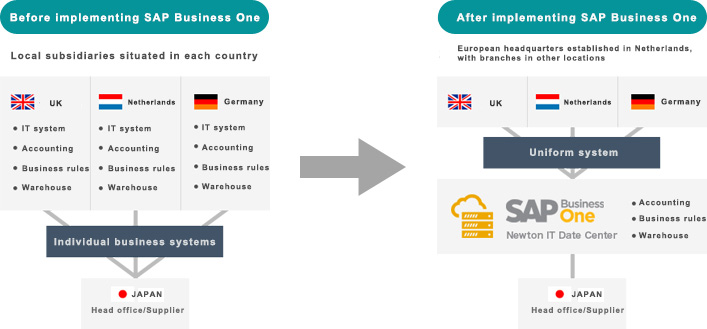SAP Business One case study
Client Profile
A manufacturing company headquartered in Japan.Expanding sales operations to the UK, Netherlands and Germany.Around 60 users.
Project overview
When implementing a new system to accompany their European business integration, the client used our system integration service to develop a business system together with the IT infrastructure to support it.The business systems implemented at each site were integrated into SAP Business One, and a system configuration that maximised the business integration effect was achieved through server virtualisation and a ‘thin client’ approach.After implementation, we also provided a hybrid operation service to support operations on both the business systems and the IT infrastructure side.

By integrating the various business systems used at each site, the client was able to reduce costs, improve business efficiency and quality, and optimise IT investments.
| Issues before implementation | |
|---|---|
| Inventory and logistics | • Warehouse maintenance costs were incurred at each site, making it difficult to optimise logistical costs • In order to ensure safety stock at each site, excess stock was generated across Europe. • Increase in head office’s logistical costs due to delivery to separate locations |
| Accounting and management | • In addition to having to settle accounts at each site, consolidated accounts for three companies needed to be settled at the European head office • Different business rules for each site, making headquarters-led governance difficult |
| Business systems | • Order data from each site was not standardised, so needless processing occurred whenever data was imported into the head office order-receiving system • Systems at each site were individually implemented and operated, and the resulting operating and licensing costs hindered efficiency • Man-hours were wasted managing duplicate data |
| Automated processing | • No automated processing included in business systems, which meant business process such as warehousing, shopping, master updates and ATP took additional time |
| Operation | • Necessary to maintain a system at each site, with accompanying server and licence costs as well as system operation personnel • E-mail and file servers were different at each site, making smooth information sharing difficult |
| Benefits of implementation | |
|---|---|
| Inventory and logistics | • Reduction of surplus inventory and maintenance/management costs in Europe by entrusting warehouse operations to a logistics company and setting up a centralised warehouse in the Netherlands • Reduction of man-hours by unifying orders • Reduction of material costs by consolidating shipping lots and destinations |
| Accounting and management | • Grouping all business functions other than sales at the European headquarters to reduce overall man-hours • Processing and governance brought into line with a single set of business rules • Consolidated European accounting became unnecessary, while the head office in Japan was also consolidated as one location, reducing the number of accounting man-hours |
| Business systems | • SAP Business One introduced as a Europe-wide business system to optimise IT investment • Improved accuracy of information by centrally managing product and price data, as well as Europe-wide customer data • Reduction in man-hours required for processing on the Japanese side by enabling the provision of unified order data • Governance implemented by head office’s IT department |
| Automated processing | • Stocking information immediately reflected at logistics company’s warehouse, with automatic shipping instructions issued to the logistics company to improve the efficiency of business processes • Development of mechanism to automatically reflect product price information in the price master on the new business system, reducing business man-hours • Automated ATP to improve operational effectiveness and speed of responding to customers |
| System operation | • Server and license costs reduced by integrating systems at the data centre • Operating costs optimised by unifying system operations such as the addition of new functions or patching • Easy sharing of information through the use of a shared file server and mail server across all sites |
